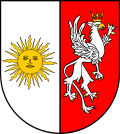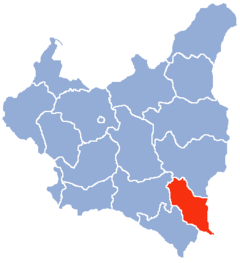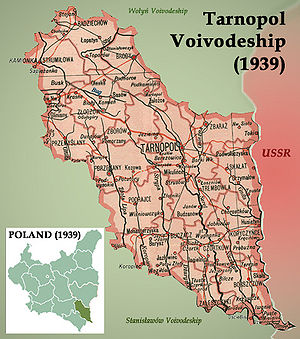
Tarnopol Voivodeship
Encyclopedia
| Tarnopol Voivodeship Województwo tarnopolskie |
|
| order="0" cellpadding="2" cellspacing="0"> |  |
| Coat of Arms |

Ternopil
Ternopil , is a city in western Ukraine, located on the banks of the Seret River. Ternopil is one of the major cities of Western Ukraine and the historical region of Galicia...
Density
Population density
Population density is a measurement of population per unit area or unit volume. It is frequently applied to living organisms, and particularly to humans...
97 p/km²
Powiat
A powiat is the second-level unit of local government and administration in Poland, equivalent to a county, district or prefecture in other countries. The term powiat is most often translated into English as "county", although other terms are also sometimes used...
s
Ternopil
Ternopil , is a city in western Ukraine, located on the banks of the Seret River. Ternopil is one of the major cities of Western Ukraine and the historical region of Galicia...
, Brody
Brody
Brody is a city in the Lviv Oblast of western Ukraine. It is the administrative center of the Brody Raion , and is located in the valley of the upper Styr River, approximately 90 kilometres northeast of the oblast capital, Lviv...
Brzeżany
Berezhany
Berezhany is a city located in the Ternopil Oblast of western Ukraine. It is the administrative center of the Berezhanskyi Raion , and rests about 100 km from Lviv and 50 km from the oblast capital, Ternopil. The city has a population of about 20,000, and is about 400 m above sea level...
, Buczacz
Buchach
Buchach is a small city located on the Strypa River in the Ternopil Oblast of western Ukraine...
, Czortków
Chortkiv
Chortkiv is a city in the Ternopil oblast in western Ukraine. It is the administrative center of the Chortkiv Raion . Population: 29,057...
Poles
Poles
thumb|right|180px|The state flag of [[Poland]] as used by Polish government and diplomatic authoritiesThe Polish people, or Poles , are a nation indigenous to Poland. They are united by the Polish language, which belongs to the historical Lechitic subgroup of West Slavic languages of Central Europe...
Ukrainians
Ukrainians
Ukrainians are an East Slavic ethnic group native to Ukraine, which is the sixth-largest nation in Europe. The Constitution of Ukraine applies the term 'Ukrainians' to all its citizens...
Jews
- 789,114 (49.3%)
- 728,135 (45.5%)
- 78,932 (4.9%)

Poland
Poland , officially the Republic of Poland , is a country in Central Europe bordered by Germany to the west; the Czech Republic and Slovakia to the south; Ukraine, Belarus and Lithuania to the east; and the Baltic Sea and Kaliningrad Oblast, a Russian exclave, to the north...
(1918–1939) with an area of 16,500 km², 17 counties, and capital in Tarnopol. At the end of World War II
World War II
World War II, or the Second World War , was a global conflict lasting from 1939 to 1945, involving most of the world's nations—including all of the great powers—eventually forming two opposing military alliances: the Allies and the Axis...
, at the insistence of Joseph Stalin during Tehran Conference
Tehran Conference
The Tehran Conference was the meeting of Joseph Stalin, Franklin D. Roosevelt and Winston Churchill between November 28 and December 1, 1943, most of which was held at the Soviet Embassy in Tehran, Iran. It was the first World War II conference amongst the Big Three in which Stalin was present...
of 1943, Poland's borders were redrawn
Territorial changes of Poland after World War II
The territorial changes of Poland after World War II were very extensive. In 1945, following the Second World War, Poland's borders were redrawn following the decisions made at the Potsdam Conference of 1945 at the insistence of the Soviet Union...
, Polish population forcibly resettled
Repatriation of Poles
Repatriation of Poles can refer to:*Repatriation of Poles *Repatriation of Poles...
and Tarnopol Voivodeship was incorporated into the Ukrainian Soviet Socialist Republic. Since 1991, most part of it belongs to Ternopil Oblast
Ternopil Oblast
Ternopil Oblast is an oblast' of Ukraine. Its administrative center is Ternopil, through which flows the Seret River, a tributary of the Dnister.-Geography:...
in sovereign Ukraine
Ukraine
Ukraine is a country in Eastern Europe. It has an area of 603,628 km², making it the second largest contiguous country on the European continent, after Russia...
.
September 1939 and its aftermath
On September 17, 1939, following German aggression on PolandInvasion of Poland (1939)
The Invasion of Poland, also known as the September Campaign or 1939 Defensive War in Poland and the Poland Campaign in Germany, was an invasion of Poland by Germany, the Soviet Union, and a small Slovak contingent that marked the start of World War II in Europe...
(see also: Polish September Campaign) and in accordance with the secret protocol of Molotov–Ribbentrop Pact, Soviet forces, allied with Nazi Germany
Nazi Germany
Nazi Germany , also known as the Third Reich , but officially called German Reich from 1933 to 1943 and Greater German Reich from 26 June 1943 onward, is the name commonly used to refer to the state of Germany from 1933 to 1945, when it was a totalitarian dictatorship ruled by...
, invaded eastern Poland
Soviet invasion of Poland
Soviet invasion of Poland can refer to:* the second phase of the Polish-Soviet War of 1920 when Soviet armies marched on Warsaw, Poland* Soviet invasion of Poland of 1939 when Soviet Union allied with Nazi Germany attacked Second Polish Republic...
. As bulk of the Polish Army was concentrated in the west, fighting Germans, the Soviets met with little resistance and their troops quickly moved westwards. Tarnopol was occupied as early as September 18, without any real opposition from the Poles, and remained in Soviet hands till Operation Barbarossa
Operation Barbarossa
Operation Barbarossa was the code name for Germany's invasion of the Soviet Union during World War II that began on 22 June 1941. Over 4.5 million troops of the Axis powers invaded the USSR along a front., the largest invasion in the history of warfare...
.
In the years 1942–1944 Tarnopol Voivodeship was one of the sites of Volhynian genocide
Massacres of Poles in Volhynia
The Massacres of Poles in Volhynia and Eastern Galicia were part of an ethnic cleansing operation carried out by the Ukrainian Insurgent Army West in the Nazi occupied regions of the Eastern Galicia , and UPA North in Volhynia , beginning in March 1943 and lasting until the end of...
spilling from neighboring Wołyń province, with summary massacres of Poles
Massacres of Poles in Volhynia
The Massacres of Poles in Volhynia and Eastern Galicia were part of an ethnic cleansing operation carried out by the Ukrainian Insurgent Army West in the Nazi occupied regions of the Eastern Galicia , and UPA North in Volhynia , beginning in March 1943 and lasting until the end of...
in literally hundreds of Tarnopol villages: i.e. Berezowica Mała (130), Łozowa (120), Ihrowica (90), Płotycza (43), etc. The slaughter of civilians, women and children alike, was conducted mostly by OUN-UPA bands of Ukrainian nationalists and lasted well into 1945, beyond the Soviet front.
Demographics
The capital of Tarnopol Voivodeship was TarnopolTernopil
Ternopil , is a city in western Ukraine, located on the banks of the Seret River. Ternopil is one of the major cities of Western Ukraine and the historical region of Galicia...
(now Ternopil, Ukraine). In 1921, it was inhabited by 1,428,520 people, and the population density was 88 persons per km². Half of the population was Polish, around 45% Ukrainians
Ukrainians
Ukrainians are an East Slavic ethnic group native to Ukraine, which is the sixth-largest nation in Europe. The Constitution of Ukraine applies the term 'Ukrainians' to all its citizens...
(mainly in the countryside, villages and smaller towns), and Jews
Jews
The Jews , also known as the Jewish people, are a nation and ethnoreligious group originating in the Israelites or Hebrews of the Ancient Near East. The Jewish ethnicity, nationality, and religion are strongly interrelated, as Judaism is the traditional faith of the Jewish nation...
(mainly in towns) made around 5%. In 1931 the population grew to 1,600,400 and the density to 97 persons per km2.
Religion was 60% Greek Catholic, 31% Roman Catholic, 9% Jewish. Ethnic Rusyn
Rusyns
Carpatho-Rusyns are a primarily diasporic ethnic group who speak an Eastern Slavic language, or Ukrainian dialect, known as Rusyn. Carpatho-Rusyns descend from a minority of Ruthenians who did not adopt the use of the ethnonym "Ukrainian" in the early twentieth century...
Greek Catholics and Polish-speaking secular Jews were in some cases classified as gentile Poles
Poles
thumb|right|180px|The state flag of [[Poland]] as used by Polish government and diplomatic authoritiesThe Polish people, or Poles , are a nation indigenous to Poland. They are united by the Polish language, which belongs to the historical Lechitic subgroup of West Slavic languages of Central Europe...
in the ethnic census, and not as Ukrainians
Ukrainians
Ukrainians are an East Slavic ethnic group native to Ukraine, which is the sixth-largest nation in Europe. The Constitution of Ukraine applies the term 'Ukrainians' to all its citizens...
or Polish Jews
Jews
The Jews , also known as the Jewish people, are a nation and ethnoreligious group originating in the Israelites or Hebrews of the Ancient Near East. The Jewish ethnicity, nationality, and religion are strongly interrelated, as Judaism is the traditional faith of the Jewish nation...
; this explains the difference between the religious and ethnic census numbers.
Geography
The Voivodeship's area was 16,533 square kilometers. It was located in south-eastern corner of Poland, bordering Soviet Union to the east, Lwów VoivodeshipLwów Voivodeship
Lwów Voivodeship was an administrative unit of interwar Poland . According to Nazis and Soviets it ceased to exist in September 1939, following German and Soviet aggression on Poland . The Polish underground administration existed till August 1944.-Population:Its capital, biggest and most...
and Stanisławów Voivodeship to the west, Romania
Romania
Romania is a country located at the crossroads of Central and Southeastern Europe, on the Lower Danube, within and outside the Carpathian arch, bordering on the Black Sea...
to the south and Volhynian Voivodeship to the north. The landscape was hilly, with the Podole
Podole
Podole may refer to:*Podolia, a region in Ukraine*Podole, Aleksandrów County in Kuyavian-Pomeranian Voivodeship *Podole, Lipno County in Kuyavian-Pomeranian Voivodeship...
upland covering large part of the Voivodeship. In the north-west there is the Gologory range, with the Kamula (473 meters above sea level) as the highest peak (however, the Kamula was located some 5 kilometers behind the Voivodeship's borderline, in the Lwów Voivodeship). South of the Voivodeship was known for its wineries and peach orchards.
The Dniester
Dniester
The Dniester is a river in Eastern Europe. It runs through Ukraine and Moldova and separates most of Moldova's territory from the breakaway de facto state of Transnistria.-Names:...
and the Seret
Seret
Seret may refer to:* Seret River* Seret River * Seret...
were the main rivers. Border with the Soviet Union was marked by the Zbrucz river, along its whole course. Border of the Voivodeship (and at the same time - of Poland) with Romania was marked by the Dniester. The south-easternmost place was the famous Polish stronghold Okopy Swietej Trojcy (Ramparts of the Hole Trinity), which for some time was protecting Poland from the invasions of the Turks
Turkish people
Turkish people, also known as the "Turks" , are an ethnic group primarily living in Turkey and in the former lands of the Ottoman Empire where Turkish minorities had been established in Bulgaria, Cyprus, Bosnia and Herzegovina, Georgia, Greece, Kosovo, Macedonia, and Romania...
and the Tartars.
Administrative subdivisions
The Tarnopol Voivodeship consisted of 17 powiats (counties), 35 towns and 1087 villages. Its capital was also its largest city, with population of some 34,000 (as for 1931). Other important municipal centers of the voivodeship were: Czortkow (pop. 19,000), BrodyBrody
Brody is a city in the Lviv Oblast of western Ukraine. It is the administrative center of the Brody Raion , and is located in the valley of the upper Styr River, approximately 90 kilometres northeast of the oblast capital, Lviv...
(pop. 16,400), Zloczow (pop. 13,000), Brzeżany (pop. 12,000) and Buczacz (pop. 11,000).
The Tarnopol Voivodeship consisted of 17 powiat
Powiat
A powiat is the second-level unit of local government and administration in Poland, equivalent to a county, district or prefecture in other countries. The term powiat is most often translated into English as "county", although other terms are also sometimes used...
s (counties
County
A county is a jurisdiction of local government in certain modern nations. Historically in mainland Europe, the original French term, comté, and its equivalents in other languages denoted a jurisdiction under the sovereignty of a count A county is a jurisdiction of local government in certain...
):
- Borszczów Powiat (1067 km²),
- BrodyBrodyBrody is a city in the Lviv Oblast of western Ukraine. It is the administrative center of the Brody Raion , and is located in the valley of the upper Styr River, approximately 90 kilometres northeast of the oblast capital, Lviv...
Powiat (1125 km²)
(1125 km²) - Brzeżany Powiat (1135 km²)
- Buczacz Powiat (1208 km²)
- Czortków Powiat
 (734 km²)
(734 km²) - Kamionka StrumiłowaKamianka-BuzkaKamianka-Buzka is a city in the Lviv Oblast, of western Ukraine. It is the administrative center of the Kamianka-Buzkyi Raion . The city was previously known as Kamianka Strumilowa, and was a district city in Galicia...
Powiat (1000 km²) - Kopyczyńce Powiat (841 km²)
- Podhajce Powiat
 (1018 km²)
(1018 km²) - Przemyślany Powiat (927 km²)
- RadziechówRadziechówRadziechów may refer to the following places in Poland:*Radziechów in Gmina Zagrodno, Złotoryja County in Lower Silesian Voivodeship *Other places called Radziechów ...
Powiat (1022 km²) - SkałatSkalatSkalat is a small city in the Ternopil Oblast of western Ukraine. It is located in the Pidvolochysk Raion , at around .-External links:* - Transcripts of eyewitness testimonies...
Powiat (876 km²)
(876 km²) - Tarnopol Powiat
 (1231 km²)
(1231 km²) - Trembowla Powiat (789 km²)
- Zaleszczyki Powiat
 (684 km²)
(684 km²) - Zbaraż Powiat (740 km²)
- ZborówZborivZboriv is a small town in Ternopil Oblast, west Ukraine. It is located in the historical region of Galicia. The population is 7,400 . It is administrative center of the Zboriv Raion....
Powiat (941 km²) - Zloczów Powiat (1195 km²)
Railroads and industry
Tarnopol Voivodeship was located in the so-called Poland "B", which meant that it was underdeveloped, with scarce industry. However, agricultural production was good, due to moderate climate and rich, fertile black soil common in these areas of Europe. Southern part was popular among tourists, with the main center in Zaleszczyki - a border-town, located on the Dniestr, where one could spot unique in Poland grapewines. Railroad network was better developed in the south, with numerous local connections. Major rail junctions were: Tarnopol, Krasne, Kopczynce. On January 1, 1938, total length of railroads within Voivodeship's boundaries was 931 kilometers (5.6 km. per 100 km²)Voivodes
- Karol Olpiński 23 April 1921 – 23 January 1923
- Lucjan Zawistowski 24 February 1923 – 16 February 1927
- Mikołaj Kwaśniewski 16 February 1927 – 28 November 1928 (acting till 28 December 1927)
- Kazimierz Moszyński 28 November 1928 – 10 October 1933
- Artur Maruszewski 21 October 1933 – 15 January 1935 (acting till 6 March 1934)
- Kazimierz Gintowt-Dziewiałtowski 19 January 1935 – 15 July 1936 (acting )
- Alfred Biłyk 15 July 1936 – 16 April 1937
- Tomasz Malicki 16 April 1937 – 17 September 1939

